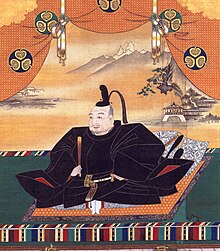
Back Ieyasu Tokugawa AN توكوغاوا إيه-ياسو Arabic توكوجاوا ايه ياسو ARZ Tokugawa Ieyasu AST Tokuqava İeyasu Azerbaijani Токугава Иэясу Bashkir Tokugawa Ieyasu BAN Такугава Іэясу Byelorussian Токугава Иеясу Bulgarian Tokugawa Ieyasu Breton
Tokugawa Ieyasu[a][b] (born Matsudaira Takechiyo;[c] January 31, 1543 – June 1, 1616) was the founder and first shōgun of the Tokugawa shogunate of Japan, which ruled from 1603 until the Meiji Restoration in 1868. He was one of the three "Great Unifiers" of Japan, along with his former lord Oda Nobunaga and fellow Oda subordinate Toyotomi Hideyoshi. The son of a minor daimyo, Ieyasu once lived as a hostage under daimyo Imagawa Yoshimoto on behalf of his father. He later succeeded as daimyo after his father's death, serving as ally, vassal and general of the Oda clan,[3] and building up his strength under Oda Nobunaga.[4]
After Oda Nobunaga's death, Ieyasu was briefly a rival of Toyotomi Hideyoshi, before declaring his allegiance to Toyotomi and fighting on his behalf. Under Toyotomi, Ieyasu was relocated to the Kanto plains in eastern Japan, away from the Toyotomi power base in Osaka. He built his castle in the fishing village of Edo (now Tokyo). He became the most powerful daimyo and the most senior officer under the Toyotomi regime. Ieyasu preserved his strength during Toyotomi's failed attempts to conquer Korea. After Hideyoshi's death, Ieyasu seized power in 1600, after the Battle of Sekigahara.[3][page needed] He received appointment as shōgun in 1603, and voluntarily abdicated from office in 1605, but remained in power until his death in 1616. He implemented a set of careful rules known as the bakuhan system, designed to keep the daimyo and samurai in check under the Tokugawa Shogunate.[3][4]
Cite error: There are <ref group=lower-alpha> tags or {{efn}} templates on this page, but the references will not show without a {{reflist|group=lower-alpha}} template or {{notelist}} template (see the help page).
© MMXXIII Rich X Search. We shall prevail. All rights reserved. Rich X Search

